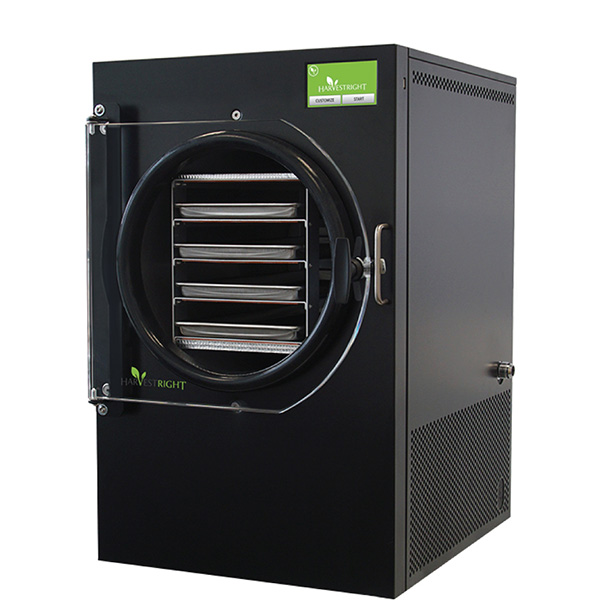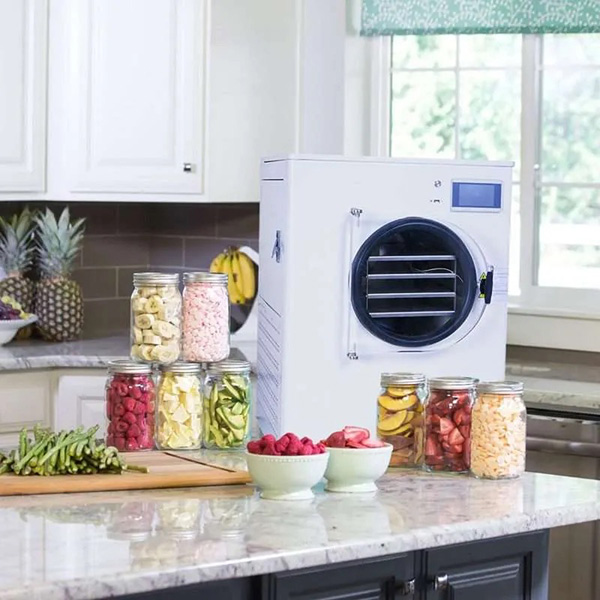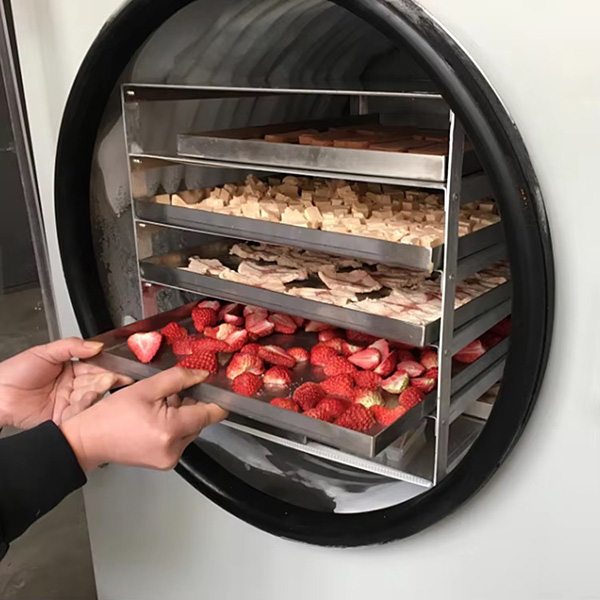
Content Menu
● Introduction to Food Freeze Drying
● Understanding the Food Freeze Dry Machine
>> Key Components of a Food Freeze Dry Machine
● The Freeze Drying Process: Step by Step
>> 1. Preparation
>> 2. Freezing
>> 3. Primary Drying (Sublimation)
>> 4. Secondary Drying (Desorption)
>> 5. Sealing and Storage
● Benefits of Using a Food Freeze Dry Machine
>> 1. Superior Nutrient Retention
>> 2. Extended Shelf Life
>> 3. Lightweight and Compact
>> 4. Retention of Original Flavor and Texture
>> 5. Versatility
>> 6. Additive-Free Preservation
● Applications of Food Freeze Dry Machines
>> 1. Food Industry
>> 2. Pharmaceutical Industry
>> 3. Biotechnology
>> 4. Space Exploration
>> 5. Military and Emergency Services
>> 6. Home Use
● Choosing the Right Food Freeze Dry Machine
>> 1. Capacity
>> 2. Size and Space Requirements
>> 3. Energy Efficiency
>> 4. Ease of Use
>> 5. Maintenance and Cleaning
>> 6. Cost
● Tips for Successful Freeze Drying
● The Future of Food Preservation: Innovations in Freeze Dry Technology
● Conclusion: Embracing the Freeze Dry Revolution
● Frequently Asked Questions about Food Freeze Dry Machines
>> 1. How long does the freeze-drying process typically take?
>> 2. Can all types of food be freeze-dried?
>> 3. How do freeze-dried foods compare nutritionally to fresh foods?
>> 4. Are home freeze dry machines worth the investment?
>> 5. How do you rehydrate freeze-dried food?
Introduction to Food Freeze Drying
Freeze drying, also known as lyophilization, is a cutting-edge food preservation method that has gained significant popularity in recent years. At the heart of this process is the food freeze dry machine, a sophisticated piece of equipment that has revolutionized the way we preserve food. This comprehensive guide will delve into the intricacies of food freeze dry machines, their applications, benefits, and the science behind this remarkable technology.
Understanding the Food Freeze Dry Machine
A food freeze dry machine is a specialized appliance designed to remove moisture from food products through a process called sublimation. This process involves freezing the food and then reducing the surrounding pressure to allow the frozen water in the food to sublimate directly from the solid phase to the gas phase.
Key Components of a Food Freeze Dry Machine
1. Freezing chamber: Where food is placed and rapidly frozen to very low temperatures.
2. Vacuum pump: Creates a low-pressure environment necessary for sublimation.
3. Heating elements: Provide the energy needed for sublimation to occur.
4. Condenser: Captures the water vapor released during the process.
5. Control panel: Allows users to monitor and adjust the freeze-drying process.
The Freeze Drying Process: Step by Step
Understanding the freeze-drying process is crucial to appreciating the value of food freeze dry machines. Let's break down the process into its main stages:
1. Preparation
Before freeze-drying begins, food is typically pre-treated. This may involve cutting into smaller pieces, blanching, or pre-freezing, depending on the type of food being processed.
2. Freezing
The prepared food is placed in the freeze dry machine's chamber, where it's rapidly frozen to temperatures between -30°F and -50°F (-34°C to -45°C). This quick freezing helps preserve the food's structure and nutrients.
3. Primary Drying (Sublimation)
Once frozen, the chamber's pressure is reduced, and a small amount of heat is applied. This creates the perfect conditions for sublimation, where ice in the food transitions directly from a solid to a gas without passing through the liquid phase.
4. Secondary Drying (Desorption)
After most of the ice has sublimated, the temperature is raised slightly to remove any remaining bound water molecules. This ensures that the food is thoroughly dried and shelf-stable.
5. Sealing and Storage
Once the drying process is complete, the freeze-dried food is quickly sealed in moisture-proof packaging to prevent rehydration.

Benefits of Using a Food Freeze Dry Machine
The popularity of food freeze dry machines stems from the numerous advantages they offer over traditional food preservation methods:
1. Superior Nutrient Retention
Freeze-drying preserves up to 97% of the food's nutritional value, significantly higher than other preservation methods like canning or dehydrating.
2. Extended Shelf Life
Properly freeze-dried and packaged foods can last up to 25 years, making them ideal for long-term storage and emergency preparedness.
3. Lightweight and Compact
Freeze-dried foods are incredibly lightweight, typically weighing only 20% of their original weight, making them perfect for camping, hiking, and space travel.
4. Retention of Original Flavor and Texture
Unlike other preservation methods, freeze-drying maintains the food's original flavor, color, and texture, ensuring a more enjoyable eating experience upon rehydration.
5. Versatility
A wide variety of foods can be freeze-dried, including fruits, vegetables, meats, dairy products, and even entire meals.
6. Additive-Free Preservation
Freeze-drying eliminates the need for chemical preservatives, appealing to health-conscious consumers.
Applications of Food Freeze Dry Machines
The versatility of food freeze dry machines has led to their adoption across various industries and applications:
1. Food Industry
Freeze-dried ingredients are used in instant soups, ready-to-eat meals, and snack foods. They're also popular in the production of lightweight camping and backpacking meals.
2. Pharmaceutical Industry
Freeze-drying is used to preserve vaccines, antibiotics, and other sensitive biological materials.
3. Biotechnology
Researchers use freeze-drying to preserve cell cultures, enzymes, and other biological samples for long-term storage.
4. Space Exploration
NASA and other space agencies use freeze-dried foods to provide astronauts with nutritious, lightweight meals during space missions.
5. Military and Emergency Services
Freeze-dried meals are a staple in military rations and emergency food supplies due to their long shelf life and nutritional value.
6. Home Use
With the availability of home freeze dry machines, more individuals are using this technology for personal food preservation and emergency preparedness.

Choosing the Right Food Freeze Dry Machine
When selecting a food freeze dry machine, consider the following factors:
1. Capacity
Determine how much food you plan to freeze dry at once. Home units typically handle 4-10 pounds per batch, while commercial machines can process much larger quantities.
2. Size and Space Requirements
Ensure you have adequate space for the machine, considering both its footprint and the need for proper ventilation.
3. Energy Efficiency
Look for models with good energy ratings, as freeze-drying can be an energy-intensive process.
4. Ease of Use
Consider machines with user-friendly interfaces and clear instructions, especially if you're new to freeze-drying.
5. Maintenance and Cleaning
Opt for machines that are easy to clean and maintain to ensure longevity and hygiene.
6. Cost
Balance the initial investment against the long-term savings and benefits of freeze-drying your own food.
Tips for Successful Freeze Drying
To get the most out of your food freeze dry machine, follow these tips:
1. Pre-freeze foods when possible to reduce overall processing time.
2. Cut foods into uniform sizes for even drying.
3. Avoid overloading the machine, as this can lead to incomplete drying.
4. Use appropriate packaging materials to ensure long-term storage.
5. Label freeze-dried foods with the date of processing and contents.
6. Store freeze-dried foods in a cool, dry place away from direct sunlight.
The Future of Food Preservation: Innovations in Freeze Dry Technology
As technology advances, we can expect to see further innovations in food freeze dry machines:
1. Increased energy efficiency and faster processing times.
2. Smart features and IoT integration for remote monitoring and control.
3. Improved vacuum and refrigeration systems for better results.
4. Development of more compact and affordable home units.
5. Integration with other food preservation technologies for hybrid solutions.

Conclusion: Embracing the Freeze Dry Revolution
Food freeze dry machines have undoubtedly transformed the landscape of food preservation. From extending shelf life and retaining nutritional value to enabling new culinary possibilities, these machines offer a wealth of benefits for both commercial and home users. As technology continues to evolve, we can expect freeze-drying to play an increasingly important role in ensuring food security, reducing waste, and providing high-quality, nutritious food options for people around the world.
Whether you're a food industry professional, a prepper, or simply someone interested in exploring new ways to preserve food, a food freeze dry machine could be a valuable addition to your toolkit. By understanding the process, benefits, and applications of freeze-drying, you'll be well-equipped to make informed decisions about incorporating this technology into your food preservation strategy.
Frequently Asked Questions about Food Freeze Dry Machines
1. How long does the freeze-drying process typically take?
Answer: The freeze-drying process can take anywhere from 20 to 40 hours, depending on the type and quantity of food being processed. Factors such as water content, thickness of the food, and the efficiency of the machine can affect the duration.
2. Can all types of food be freeze-dried?
Answer: While most foods can be freeze-dried, some are better suited to the process than others. Foods with high fat content, such as avocados, may not freeze-dry well. However, fruits, vegetables, meats, dairy products, and even complete meals can be successfully freeze-dried.
3. How do freeze-dried foods compare nutritionally to fresh foods?
Answer: Freeze-dried foods retain up to 97% of their original nutritional value. This is significantly higher than other preservation methods like canning or dehydrating, which can result in greater nutrient loss.
4. Are home freeze dry machines worth the investment?
Answer: For many people, home freeze dry machines are a worthwhile investment. They allow for long-term food storage, reduce food waste, and can save money in the long run, especially for those who grow their own produce or buy in bulk. However, the initial cost and energy consumption should be considered when making the decision.
5. How do you rehydrate freeze-dried food?
Answer: Rehydrating freeze-dried food is typically simple. Most foods can be rehydrated by adding warm or room temperature water. The amount of water and time needed varies depending on the food, but generally, it takes about 5-10 minutes for the food to absorb the water and regain its original texture.This comprehensive guide to food freeze dry machines covers the key aspects of this innovative technology, from its basic principles to practical applications and future developments. By understanding the capabilities and benefits of these machines, you can make informed decisions about incorporating freeze-drying into your food preservation strategy, whether for personal use or commercial applications.












